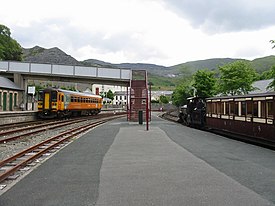Conwy Valley Line
| Conwy Valley line | |||
|---|---|---|---|

Blaenau Ffestiniog, the interchange between Conwy Valley trains and the narrow gauge Ffestiniog Railway
|
|||
| Overview | |||
| Type | Heavy Rail | ||
| Locale |
Conwy Gwynedd |
||
| Termini |
Llandudno Blaenau Ffestiniog |
||
| Stations | 13 | ||
| Operation | |||
| Opened | 1879 | ||
| Owner | Network Rail | ||
| Operator(s) | Arriva Trains Wales | ||
| Character | Rural | ||
| Rolling stock |
Class 150 "Sprinter" Class 153 "Super Sprinter" |
||
| Technical | |||
| Line length | 30.8 miles (49.6 km) | ||
| Number of tracks | 2 (Llandudno–Llandudno Junction) 1 (Llandudno Junction–North Llanrwst) 2 (Passing loop at North Llanrwst) 1 (North Llanrwst–Blaenau Ffestiniog) |
||
| Track gauge | 4 ft 8 1⁄2 in (1,435 mm) standard gauge | ||
|
|||
The Conwy Valley line (Welsh: Lein Dyffryn Conwy) is a railway line in north-west Wales. It runs from Llandudno via Llandudno Junction (Welsh: Cyffordd Llandudno) to Blaenau Ffestiniog, and was originally part of the London and North Western Railway, being opened in stages to 1879. The primary purpose of the line was to carry slate from the Ffestiniog quarries to a specially built quay at Deganwy for export by sea. The line also provided goods facilities for the market town of Llanrwst, and via the extensive facilities at Betws-y-Coed on the London to Holyhead A5 turnpike road it served many isolated communities in Snowdonia and also the developing tourist industry. Although only a little over 27 miles (43 km) between Llandudno and Blaenau Ffestiniog, the journey takes over one hour. Most of the stations along the route are treated as a request stop.
The first section from Llandudno Junction to Llanrwst (now called North Llanrwst) was built as the Conway and Llanrwst Railway and opened in 1863. The LNWR took over in 1863 and opened the extension to Betws-y-Coed in 1868.
The next extension was to Blaenau Ffestiniog to access the output of the large slate quarries there. At first the LNWR proposed a 2' narrow gauge railway via the steeply graded Lledr Valley to Blaenau Ffestiniog, this being the 'Bettws & Festiniog Railway'; authorisation was sought in November 1870. After construction began, it was decided that the extension would be built to standard gauge, allowing through running of trains. Between 1874 and 1879 the railway tunnel underneath Moel Dyrnogydd was bored, and in July 1879 a terminus was initially opened by the tunnel entrance. The line was subsequently extended by the best part of a mile to a terminus in the town, which opened 31 March 1881.
...
Wikipedia

